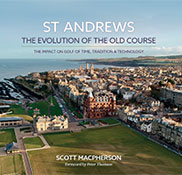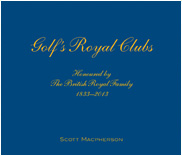GOLF CHAMPIONSHIPS ON SMGD COURSES:
At Close House – Colt Course. Sept 2017. A prestigious European Tour Championship hosted by Lee Westwood.
Broadcast worldwide from Royal Wellington Golf Club, NZ. October 2017. WOW!
The legacy continues.
Co-hosted at the award-winning Millbrook Resort near Queenstown, NZ. 2014 – 2023.
Replica Designs. Tribute or Travesty?
Edited Version for ‘The Cut’. Published in ‘The Cut’- October ‘06.
The greatest golf courses in the world are those where time-proven and tested design strategies are seamlessly massaged into the folds of the earth. The greatest holes are masterful, individual creations of beauty, interest and excitement for golfers of all abilities. Astute golf architects have applied creative imitation into their designs for many years, but in a new trend, replicating principles has been replaced by replicating entire holes. Can the practice of reproducing holes in their entirety ever capture the magical essence of the original experience?
In America, C.B. Macdonald, now considered by golf historians the “father of American golf architecture”, was the first architect to announce and complete the reproduction of existing holes in 1911. Macdonald designed The National Golf Links of America on the eastern end of Long Island (NY) to embody the best elements of the great Links of Scotland and England. Writing about ‘The National’ in 1928, Macdonald proffered, ‘Don’t seek an original idea in building a golf course’, later continuing, ‘one must have the gift of imagination to successfully apply the original to new situations’. Macdonald saw wisdom in, from classical courses, copying ‘holes which have the testimony of all the great golfers for more than a century or two past as being the best and noblest phases of the game’.
While Macdonald, Seth Raynor and Charles Banks were responsible for various early versions of The Redan, other holes have not escaped the dubious honour of being replicated. The ‘Postage stamp’ at Royal Troon and the 11th Hole on the Old Course in St Andrews are perennial favourites, and more recently the Par 3, 12th at Augusta National also.
Ironically, copies of holes at Augusta National are somewhat second generation. It is a little known fact that Augusta National was intended to be a tribute course to Bobby Jones’s favourite holes. In is book ‘Golf is my game’, 1959, he says ‘ (Dr Alister) MacKenzie and I expected to reproduce in their entirety holes of famous courses around the world where I had played in competitions.’ However as Jones realised, ‘This was, at best, a bit naive, because to do such a thing, we would have had literally to alter the face of the earth.’ So instead they decided that the course would be ‘strongly influenced by holes which either MacKenzie or I (Jones) had admired’ and they would adapt the existing terrain to certain features of their favourite holes.
Over 50 years later, in 1986, American architect Ron Garl designed Golden Ocala in Florida, and did replicate 8 entire holes in an otherwise original layout. The holes he chose to replicate came from such disparate venues as Augusta National to the Old Course and were selected on the following criteria. Golfers most want to see…
- Holes where major championships are played.
- Holes seen on Television.
- Holes with a reputation of being challenging.
- Holes that have historical significance.
- Holes that people dream of playing on famous courses that are too distant for the average golfer to travel.
During the design process however, Garl learnt that there is much more to designing replica holes than getting a hole the correct yardage, the green shape and size accurate and the bunkers positioned properly. He said, ‘You have to recreate the feel of the hole to allow the golfer to live his dream of playing the greatest holes in the world. When a golfer stands on the tee of the hole called “Hogan’s Alley”, the sixth at Carnoustie in Scotland, he has to feel the wind. He has to see the out of bounds dangerously close to the left side of the fairway and the huge pot bunkers on the right. He has to be aware of the heavy rough to the left and the feel that the British Open is on the line if he misses the fairway’.
British golf architects H.N Wethered and T. Simpson didn’t believe in replica’s- ‘A golf course… must have character and individuality because no one would be content with a mere reproduction.’ Their words rang true in the 1960’s when ‘Tory Pines’, the first 9-hole replica layout that surfaced in New Hampshire failed to survive. Some have survived however. Apart from Golden Ocola , golfers can now visit ‘The Royal Links’ in Las Vegas (Greens fees = US$225+), ‘The tribute Golf Club’ in Texas and the ‘World Tour Golf Links’ in South Carolina or the two ‘Tour 18’ courses that sold in Texas in 2003 for US$52 million! Jack Nicklaus- A man never far behind a corporate opportunity, is also cashing in on the design fetish. ‘The Bear’ has created his own ‘Bears best’ courses in Las Vegas and Atlanta by making facsimiles of his own holes.
Replica courses will never capture the spirit and authenticity of the original. Macdonald believed in Stylistic adaptations. He wrote, ‘The courses of Great Britain abound in classic and notable holes, and one has only to study them and adopt their best and boldest features.’ Following this advice, modern architects need only to understand the fundamental principles of great hole designs and tailor them to a site. Those who do this the best will create holes that, as MacKenzie wrote ‘afford the greatest pleasure to the greatest number’.
AWARDS
 Winner
Winner
Excellence in Compliance Award
Royal Wellington Golf Club
 Scott awarded by GEO as a Sustainable Golf Champion
Scott awarded by GEO as a Sustainable Golf Champion
PUBLICATIONS
 St Andrews
St Andrews
The Evolution of the Old Course
by Scott Macpherson
TESTIMONIALS
"During both the design and construction phases their can-do attitude to problem solving was refreshing".
Ben O'Malley, Millbrook Country Club, NZ



